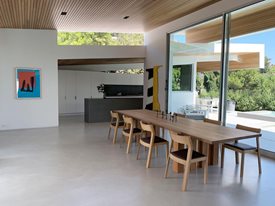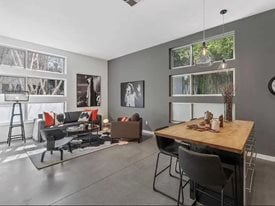
LA Concrete Works in West Hills, CA
Concrete can be given a variety of beautiful textured finishes, but for interior concrete floors, a smooth finish reigns supreme. A smooth finish gives concrete floors a sleek, high-end look and is easier to clean and maintain. Smooth finishes also make a perfect base for different decorative treatments like acid stains, concrete dyes, and floor paint.
There are a number of methods you can use to create a smooth finish in both newly placed and existing concrete. You can even make rough, damaged concrete floors smooth and even, giving them a glass-like appearance.
Troweling
To make a new concrete floor smooth, the usual method is to use a steel trowel on the wet surface. To smooth small projects, a hand trowel is pushed and pulled across the surface of the concrete. For large commercial or industrial floors, finishers use ride-on or walk-behind power trowels to obtain a smooth, even finish.
Learn more about using concrete trowels to create a smooth, dense surface.
Tip: It's best to let an experienced concrete finisher handle troweling because timing and techniques are important for good results.
Mechanical Methods
If your existing concrete floor has minor flaws or glue residue (see How to Remove Carpet Glue from Concrete Floors), mechanical methods may be needed to smooth the surface and remove imperfections.
The fastest and most efficient method is to use a concrete grinder or a floor buffer fitted with a sanding disk. Although this equipment can be rented, it can be tricky to operate if you don’t have experience. It is important to keep the grinder moving, overlapping each pass slightly, to prevent divots, uneven spots, or swirl marks in the floor.
Tip: To stay safe while grinding, wear safety glasses and a dust mask to shield yourself from dust and debris.

Gem Concrete Polishing LLC in Pleasant Hill, CA
Polishing
Polishing is one of the most popular methods for smoothing concrete floors, resulting in a high-gloss, mirror-like finish. The polishing process uses concrete floor grinders outfitted with diamond abrasives. The grade of the abrasives used, ranging from coarse to fine, will determine the final degree of shine and smoothness.
You can polish almost any structurally sound concrete floor, whether it is new or old. However, there are some exceptions, such as floors that are wavy, need extensive patching, or are extremely porous. An experienced contractor can usually determine if your floor is a good candidate for polishing.
Learn more about how to polish concrete floors.
